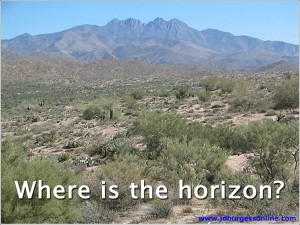-
Phil Kellison makes forced perspective easier
Posted on October 24th, 2009 No commentsPhil Kellison was one of the unsung greats in the visual effects business. He was a visual effects supervisor and designer long before that position was acknowledged in movie credits. He had an almost 40-year career that ranged from the George Pal Puppetoons to industrial films, commercials, and feature films. He had that unusual aptitude of being both the right-brained artist and the left-brained engineer.
Phil was the supervisor and boss at Cascade Picture of California when I began working there in 1969-70. I learned a lot by watching and listening to him. Phil loved the challenge of doing visual effects in-camera and his specialty was forced perspective (more correctly known now as “mixed scale”.) To market the technique to the T.V. commercial business, he dubbed it “Magnascope”.

The Jolly Rancher as seen through the camera.
-
How to use a Perspective Cube
Posted on April 14th, 2009 No commentsNew visual effects students often have difficulty with the concept and application of the “perspective cube.” A perspective cube is a well constructed box with accurate parallel edges and right angles. Usually it is white with black lines along the edges. Typical construction materials would be white foam core and one inch black paper tape along the edges.
The cube size is somewhat to taste and per your transportation restrictions but it should not be too small. Most appear to be 12″ x 12″ x 12″ or 18″ x 18″ x 18″. I suggest using whole inch measurements and make all side equal as that facilitates quicker set up and ease of reproduction in a Computer Generated Imagery (CGI) environment if needed.
 The perspective cube can be used for multiple reasons. Today we will use the perspective cube to find a horizon line that can’t be seen.
The perspective cube can be used for multiple reasons. Today we will use the perspective cube to find a horizon line that can’t be seen. Suppose you are on location where mountains or vegetation blocks your view of a horizon line and you have no other man-made structures to run perspective lines from to find a vanishing point and horizon line.
-
The next best thing to knowing something ….
Posted on April 4th, 2009 No commentsAt times students contact me about how to do certain effects or procedures in After Effects. Since I can’t always be available, I wanted to remind you that:
* You have an interactive “Help” menu at the top of your After Effects tool bar or you can hit “F1”
* Within the Help Menu, there is an “effects reference” help section that will cover most, if not all, the effects menu.
 * Also check the wonderful text book Creating Motion Graphics with After Effects by Trish and Chris Meyer.
* Also check the wonderful text book Creating Motion Graphics with After Effects by Trish and Chris Meyer. * It is a valuable reference and belongs in every animator’s, editor’s and VFX artist’s library.
* Look up the topic in the back, in the index, and it will take you to the pages that cover the subject of interest.
* You can also Google topics like “puppet tool in After Effects” or “How to use the puppet tool in After Effects”


Recent Comments